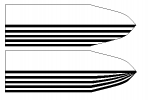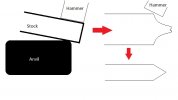- Joined
- Jul 17, 2019
- Messages
- 322
I've been wanting to do some edge bars but I've never done any before. Do you just stack two bars on top of each other and forge weld, or should I try to forge/grind an interlocking tongue and groove type thing in the middle? Should the spine bar be shorter than the edge bar to make sure the HC edge bar also curves around the point of the blade?


